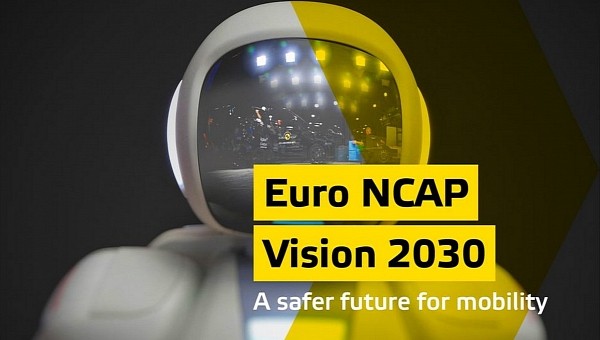Euro NCAP is in hot water after the white-hat hacker GreenTheOnly revealed that vehicles tested by the entity had specially provisioned computers and firmware that could only be considered in production because it was installed in a handful of cars. When the organization released its roadmap for new tests called Vision 2030, it should have addressed the risk of software manipulation directly, but it only talked about intentions.
According to Euro NCAP, the new tests will take into consideration “Assisted and Automated driver support systems,” driver monitoring technologies, V2X capabilities, fire and thermal runaway risks in electric cars, and “promoting best practice(s) in vehicle security and data access.”
When the Vision 2030 document reaches the chapter “Vehicle Safety and Access to Data,” it gives the impression that it will address precisely the firmware vehicles tested by Euro NCAP present, how to control what the software does, and so forth. Instead, it repeated this text in the first and second paragraphs of the document:
“The role of software and telematics has become so dominant that the industry is becoming a hyperconnected, software-driven one where data has become key to growing revenue, not just for automotive manufacturers but for many suppliers of products and services that sit adjacent to manufacturers. Consequently, what happens with the data generated by drivers and their vehicles, and who should have access has become a burning question for European legislators.”
You can check that for yourself: it is on page 25 of the document attached below. The rest of the chapter concentrates on worries that hackers may invade cars and control them. There is no single word about the risk that automakers may want to cheat to get better results in predictable tests.
The closest Euro NCAP comes to discussing that is when it talks about virtual tests to “keep the program feasible and manageable.” These tests would “require trust and cooperation with the vehicle manufacturer.” The organization also mentioned that “access to data should be made in the interest of consumers and that access to in-vehicle-data must remain possible for all authorized parties. This includes the use and monitoring of car data and functions during independent consumer testing.” That’s more than fair: it is mandatory for such tests to remain credible.
This is not the only problem Euro NCAP is facing. The document also acknowledges “the rising costs of the program” and states that “the challenges of the 2023 rating requirements will still be insurmountable for some manufacturers.” That’s an interesting choice of words when Dacia just decided not to give a damn about Euro NCAP’s ratings anymore, which pay increasing attention to active crash avoidance systems.
Among the changes Euro NCAP intends to adopt, there are valid concerns, such as evaluating the brain damage risks some crashes involve. It will also cease to assess Adult Occupant, Child Occupant, Pedestrian, and Safety Assist levels to evaluate cars according to the four phases of a wreck: Safe Driving, Crash Avoidance, Crash Protection, and Post-Crash Safety. Despite that, the document focused very little on the new dangers computers on wheels may present – and talked even less about how the organization plans to tackle them.
When the Vision 2030 document reaches the chapter “Vehicle Safety and Access to Data,” it gives the impression that it will address precisely the firmware vehicles tested by Euro NCAP present, how to control what the software does, and so forth. Instead, it repeated this text in the first and second paragraphs of the document:
“The role of software and telematics has become so dominant that the industry is becoming a hyperconnected, software-driven one where data has become key to growing revenue, not just for automotive manufacturers but for many suppliers of products and services that sit adjacent to manufacturers. Consequently, what happens with the data generated by drivers and their vehicles, and who should have access has become a burning question for European legislators.”
You can check that for yourself: it is on page 25 of the document attached below. The rest of the chapter concentrates on worries that hackers may invade cars and control them. There is no single word about the risk that automakers may want to cheat to get better results in predictable tests.
The closest Euro NCAP comes to discussing that is when it talks about virtual tests to “keep the program feasible and manageable.” These tests would “require trust and cooperation with the vehicle manufacturer.” The organization also mentioned that “access to data should be made in the interest of consumers and that access to in-vehicle-data must remain possible for all authorized parties. This includes the use and monitoring of car data and functions during independent consumer testing.” That’s more than fair: it is mandatory for such tests to remain credible.
This is not the only problem Euro NCAP is facing. The document also acknowledges “the rising costs of the program” and states that “the challenges of the 2023 rating requirements will still be insurmountable for some manufacturers.” That’s an interesting choice of words when Dacia just decided not to give a damn about Euro NCAP’s ratings anymore, which pay increasing attention to active crash avoidance systems.
Among the changes Euro NCAP intends to adopt, there are valid concerns, such as evaluating the brain damage risks some crashes involve. It will also cease to assess Adult Occupant, Child Occupant, Pedestrian, and Safety Assist levels to evaluate cars according to the four phases of a wreck: Safe Driving, Crash Avoidance, Crash Protection, and Post-Crash Safety. Despite that, the document focused very little on the new dangers computers on wheels may present – and talked even less about how the organization plans to tackle them.






























